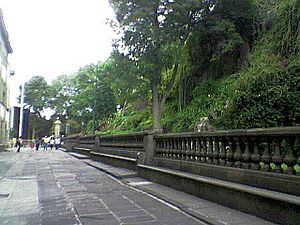Juan Diego facts for kids
Quick facts for kids SaintJuan Diego Cuāuhtlahtoātzin |
|
|---|---|
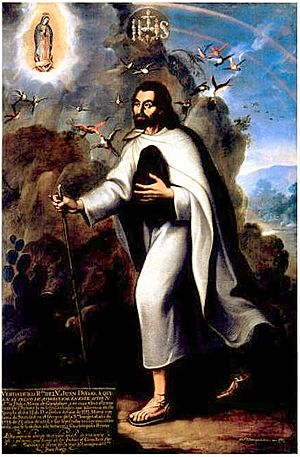
Saint Juan Diego by Miguel Cabrera, 1752
|
|
| Marian Visionary | |
| Born | Juan Diego Cuāuhtlahtoātzin 1474 Cuauhtitlán, Tenochtitlan, Aztec Empire (located in modern Mexico) |
| Died | 1548 (aged 73–74) Tepeyac, Mexico City, New Spain (located in modern Mexico) |
| Venerated in | Roman Catholic Church |
| Beatified | May 6, 1990, Basilica of Our Lady of Guadalupe, Mexico City by Pope John Paul II |
| Canonized | July 31, 2002, Basilica of Our Lady of Guadalupe, Mexico City by Pope John Paul II |
| Major shrine | Basilica of Our Lady of Guadalupe |
| Feast | December 9 |
| Attributes | Tilma with the impressed image of the Virgin Mary, roses |
| Patronage | Indigenous peoples of the Americas |
Juan Diego Cuauhtlatoatzin, also known as Juan Diego (1474–1548), was a Chichimec farmer and a visionary. He is famous for saying he saw the Virgin Mary four times in December 1531. Three times he saw her on the hill of Tepeyac, and once he saw her before don Juan de Zumárraga, who was the bishop of Mexico at the time.
The Basilica of Our Lady of Guadalupe, located at the foot of Tepeyac hill, holds a special cloak called a tilmahtli. People believe this cloak belonged to Juan Diego. They also believe that the image of the Virgin Mary was miraculously printed on it. This image is seen as proof that the visions were real.
Juan Diego's visions and the miraculous image are known as the Guadalupe event. This event is the reason why many people honor Our Lady of Guadalupe. This devotion is very common in Mexico and across Spanish-speaking countries. It is also becoming more popular in other parts of the world. Because of this, the Basilica of Our Lady of Guadalupe is one of the most visited Christian pilgrimage sites globally. In 2010, it welcomed 22 million visitors.
Juan Diego is the first Catholic saint from the native peoples of the Americas. He was declared "blessed" (beatified) in 1990 and then a "saint" (canonized) in 2002 by Pope John Paul II. The Pope traveled to Mexico City for both ceremonies.
Contents
Juan Diego's Life Story
Juan Diego was born in 1474 in Cuauhtitlan. At the time of the visions, he lived there or nearby. He was not rich or powerful, but he was not poor either. He was known for being very religious and kind. He was also very devoted to his sick uncle. These qualities show why he was chosen to become a saint.
Juan Diego and his wife, María Lucía, were among the first people to be baptized after Franciscan missionaries arrived in Mexico in 1524. His wife passed away two years before the visions happened. After the visions, Juan Diego was allowed to live near the small church built at the foot of Tepeyac hill. He spent the rest of his life serving the Virgin Mary at this shrine. He died in 1548 when he was 74 years old.
The Guadalupe Story
The story of the Guadalupe event comes from a text called the Nican mopohua. This text was first published in the Nahuatl language in 1649. The story tells us about Juan Diego's encounters with the Virgin Mary.
Juan Diego was a very religious person. He often walked from his home to the Franciscan church in Tlatelolco. He went there for religious lessons and to pray. His path took him past the hill of Tepeyac.
First Vision
On Saturday, December 9, 1531, at dawn, Juan Diego was on his usual walk. He met the Virgin Mary who told him she was the Mother of God. She asked him to tell the bishop to build a chapel in her honor. She said this chapel would be a place where she could help people in need. Juan Diego delivered the message to Bishop Juan Zumárraga. The bishop told him to come back another day after he had thought about it.
Second Vision
Later that same day, Juan Diego met the Virgin again at Tepeyac. He told her that his mission had failed. He suggested she choose someone more important for the task, saying he was "a man of no importance." But she insisted that he was the one she wanted. Juan Diego agreed to go back to the bishop. He did this on Sunday morning, December 10. This time, the bishop was more open. However, the bishop asked for a sign to prove that the vision was truly from heaven.
Third Vision
Juan Diego immediately returned to Tepeyac and told the Virgin Mary about the bishop's request for a sign. She agreed to provide one the next day, December 11.
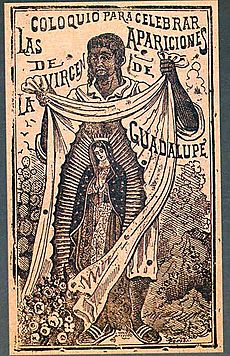
However, on Monday, December 11, Juan Diego's uncle, Juan Bernardino, became very sick. Juan Diego had to stay and take care of him. In the early hours of Tuesday, December 12, his uncle's condition worsened. Juan Diego set out for Tlatelolco to find a priest to give his uncle his last rites.
Fourth Vision
To avoid being delayed by the Virgin, Juan Diego decided to take a different path around the hill. But the Virgin stopped him and asked where he was going. Juan Diego explained what had happened. The Virgin gently reminded him that he should have come to her for help. She then spoke the famous words, "¿No estoy yo aquí que soy tu madre?" ("Am I not here, I who am your mother?"). She assured him that Juan Bernardino had already recovered. She then told him to climb the hill and gather flowers growing there. Juan Diego obeyed and found many beautiful flowers blooming out of season on the rocky hill, where only cacti usually grew. He gathered them in his cloak (his tilma). He returned to the Virgin, who rearranged the flowers and told him to take them to the bishop.
Later that day, when Juan Diego met the bishop in Mexico City, he opened his cloak. The flowers fell to the floor, and the bishop saw that an image of the Virgin Mary had been left on the cloak. The bishop immediately honored the image.
Fifth Vision
The next day, Juan Diego found his uncle completely recovered, just as the Virgin had promised. Juan Bernardino told Juan Diego that he too had seen the Virgin Mary at his bedside. She had told him to inform the bishop about her visit and his miraculous healing. She also said she wanted to be known as Guadalupe.
The bishop first kept Juan Diego's cloak in his private chapel. Then he put it on public display in the church, where it attracted much attention. On December 26, 1531, a procession carried the miraculous image back to Tepeyac. It was placed in a small chapel built quickly for it. During this procession, the first miracle linked to the image happened. An indigenous man was badly wounded in the neck by an arrow during a display. People carried him before the Virgin's image and prayed for his life. After the arrow was removed, the man made a full and immediate recovery.
Becoming a Saint
The process to make Juan Diego a saint began in 1974. This was during the 500th anniversary of his birth. In 1984, the Archbishop of Mexico, Cardinal Ernesto Corripio Ahumada, started the formal process for his canonization.
Beatification
The local investigation was finished in March 1986. The official approval to move the process to Rome was given on April 7, 1986. When the investigation was declared valid on January 9, 1987, Juan Diego officially became "venerable." The documents supporting his case were published in 1989. All the bishops of Mexico asked the Pope to support his cause.
After careful review by experts, Pope John Paul II formally approved the case on April 9, 1990. Juan Diego was declared "Blessed Juan Diego Cuauthlatoatzin" in a ceremony led by Pope John Paul II at the Basilica of Guadalupe on May 6, 1990. December 9 was set as his annual feast day. For his beatification, a miracle was not strictly required because his devotion was so old.
Miracles
Even though a miracle wasn't needed for beatification, one is usually required for someone to become a saint. The miracle accepted for Juan Diego happened between May 3 and 9, 1990, in Querétaro, Mexico. This was right around the time of his beatification. A 20-year-old man named Juan José Barragán Silva fell 10 meters (about 33 feet) headfirst from a balcony onto concrete. His mother, Esperanza, saw him fall. She prayed to Juan Diego to save her son. Juan José had severe injuries to his spine, neck, and head, including bleeding in his brain.
He was taken to the hospital and went into a coma. But he suddenly woke up on May 6, 1990. A week later, he was well enough to go home. The Catholic Church investigated this event. Doctors confirmed the severity of his injuries and that his recovery was complete and lasting. They could not explain it medically. Theologians then looked at the connection between his mother's prayers to Juan Diego and his recovery. They all agreed it was a miracle. Finally, in September 2001, the Church approved the miracle. Pope John Paul II signed the decree on December 20, 2001. The Catholic Church sees an approved miracle as a sign from God that the person should be a saint.
Canonization
The process for Juan Diego to become a saint faced some delays. In 1998, a small group of church leaders in Mexico asked for a review of the historical investigation. The Church created a special Historical Commission to look into this. The Commission's findings were approved in October 1998. Their work was published in a book called Encuentro de la Virgen de Guadalupe y Juan Diego.
However, some people still tried to stop the canonization. They argued about the historical evidence. The main argument was whether the story of the visions was as old as the devotion to Guadalupe. The Church stated that every tradition starts orally before being written down. The authenticity of the Codex Escalada (an old document) and the dating of the Nican Mopohua (the main story) were important to this discussion.
Finally, on February 26, 2002, Pope John Paul II announced that Juan Diego would be made a saint. The ceremony took place in Mexico at the Basilica of Guadalupe on July 31, 2002. After this, the Catholic Church considered the question of his existence closed.
Questions About the Story

Some people have questioned whether Juan Diego was a real person and if the visions truly happened. This debate started a long time ago. One of Juan Diego's friends, Antonio Valeriano, who was a scholar, wrote down Juan Diego's story based on what Juan Diego told him.
However, some historians, like Joaquín García Icazbalceta, pointed out that important documents from that time, including those from Bishop Zumárraga, did not mention Juan Diego or the visions. This "silence" in the records made some people wonder.
In 1996, a church leader named Guillermo Schulenburg publicly said he did not believe Juan Diego was a real person. This caused a big debate in Mexico. However, the Catholic Church's Congregation for the Causes of Saints re-examined the historical evidence in 1998 and said they were satisfied. After Juan Diego was canonized in 2002, the Catholic Church officially closed the discussion.
Juan Diego's Importance
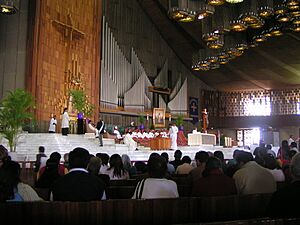
Juan Diego is very important to the Catholic Church in Mexico and beyond.
Spreading the Catholic Faith
Juan Diego is seen as a model for how the Catholic faith was spread in the New World. Pope John Paul II called him "a model of evangelization perfectly inculturated." This means that through Juan Diego and the Guadalupe event, the Catholic Church became deeply rooted within the native culture.
Bringing Cultures Together
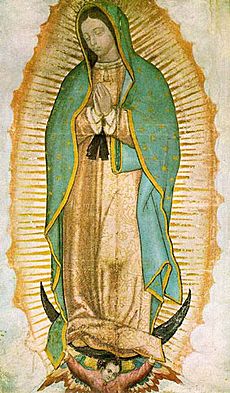
In the 17th century, some believed the Virgin Mary's message was mainly for the native people. However, Juan Diego himself saw all people in New Spain as spiritual heirs to the holy image. The story of Guadalupe helped bring together the different groups in the new society: the native people, the Spaniards, and all the mixed peoples.
Juan Diego represents the dignity of the native populations. He shows their right to have an important place in the New World. This idea has been part of the story from the very beginning. Even in the 18th century, Archbishop Lorenzana said that the Virgin Mary honored Spaniards (by the name "Guadalupe"), natives (by choosing Juan Diego), and people of mixed race (by her skin color). This shows how the story helped to harmonize and recognize the different cultures in Mexico.
See also
 In Spanish: Juan Diego Cuauhtlatoatzin para niños
In Spanish: Juan Diego Cuauhtlatoatzin para niños


